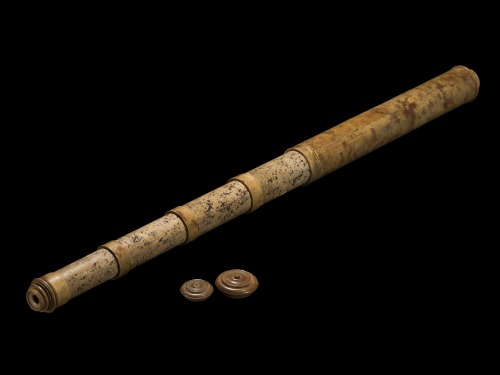Object Of The Week: Five-Draw Telescope, Unknown Maker, Italy, 1700-1750. 2018.8.5.

Object of the Week: Five-Draw Telescope, unknown maker, Italy, 1700-1750. 2018.8.5.
The introduction of the telescope in 1608 led to the production of many Galilean telescopes with a single-lens eyepiece, low magnification, and a narrow field of view. The development of the compound eyepiece in 1645 made it possible to use the telescope as a more effective device for astronomical and terrestrial observation. This example could be used for both types of observation: at 44 cm in length, it’s portable, and it provides magnification and a field of view convenient for observing both realms.
More Posts from Mainromanoff and Others

Anastasia and Dennis Klaffert shot by Kat Irlin

And that is a wrap!
Get sucked into the black hole excitement? Find out more about these unique objects and the missions we have to study them, here.
Make sure to follow us on Tumblr for your regular dose of space: http://nasa.tumblr.com.


A wall of leaves, 28-08-2021

5.23.21
reading and annotating mansfield park. it’s one of my favorite books, and one of my favorite austen novels (is that a controversial opinion?) anyway, bonus points to whoever can guess what inspired my bookmark!


nature series 3/∞
Any moment might be our last. Everything is more beautiful because we're doomed. You will never be lovelier than you are now. We will never be here again.
Homer, The Iliad

When you feel you have lost everything, you still have
books
unexpected kindness in strangers
the rest of the world to travel
languages to learn
animals to take care of
volunteer work to do
the power of a good night’s rest
the changing of seasons
infinite things to learn
billions of people to meet and possibly love
billions of people who might love you back
Needed this today






Those who dwell among the beauties and mysteries of the earth are never alone or weary of life.
- Rachel Carson
Mothers have martyred themselves in their children’s names since the beginning of time. We have lived as if she who disappears the most, loves the most. We have been conditioned to prove our love by slowly ceasing to exist.
What a terrible burden for children to bear—to know that they are the reason their mother stopped living. What a terrible burden for our daughters to bear—to know that if they choose to become mothers, this will be their fate, too. Because if we show them that being a martyr is the highest form of love, that is what they will become. They will feel obligated to love as well as their mothers loved, after all. They will believe they have permission to live only as fully as their mothers allowed themselves to live.
If we keep passing down the legacy of martyrdom to our daughters, with whom does it end? Which woman ever gets to live? And when does the death sentence begin? At the wedding altar? In the delivery room? Whose delivery room—our children’s or our own? When we call martyrdom love we teach our children that when love begins, life ends. This is why Jung suggested: There is no greater burden on a child than the unlived life of a parent.
—Glennon Doyle, Untamed

Mahmoud Darwish, from Unfortunately, It Was Paradise: Selected Poems; “The Hoopoe,”
-
 slcr303 liked this · 2 years ago
slcr303 liked this · 2 years ago -
 mortifiedandawesome liked this · 2 years ago
mortifiedandawesome liked this · 2 years ago -
 finitevariety liked this · 2 years ago
finitevariety liked this · 2 years ago -
 tooloose-lautrec reblogged this · 4 years ago
tooloose-lautrec reblogged this · 4 years ago -
 jhoriot liked this · 4 years ago
jhoriot liked this · 4 years ago -
 oochristinecuoo liked this · 4 years ago
oochristinecuoo liked this · 4 years ago -
 flowerse liked this · 4 years ago
flowerse liked this · 4 years ago -
 themuseslovechild reblogged this · 4 years ago
themuseslovechild reblogged this · 4 years ago -
 themuseslovechild liked this · 4 years ago
themuseslovechild liked this · 4 years ago -
 goodoldfashionedwitchyboy liked this · 4 years ago
goodoldfashionedwitchyboy liked this · 4 years ago -
 callmeleomercury liked this · 4 years ago
callmeleomercury liked this · 4 years ago -
 matt-murdocks-bitch liked this · 4 years ago
matt-murdocks-bitch liked this · 4 years ago -
 leahfey liked this · 4 years ago
leahfey liked this · 4 years ago -
 teenagegardendestiny liked this · 4 years ago
teenagegardendestiny liked this · 4 years ago -
 bugsrprettycool liked this · 4 years ago
bugsrprettycool liked this · 4 years ago -
 cloveroctobers liked this · 4 years ago
cloveroctobers liked this · 4 years ago -
 wwhenthepawn liked this · 4 years ago
wwhenthepawn liked this · 4 years ago -
 industrial-horror reblogged this · 4 years ago
industrial-horror reblogged this · 4 years ago -
 industrial-horror liked this · 4 years ago
industrial-horror liked this · 4 years ago -
 heart-shaped-femme liked this · 4 years ago
heart-shaped-femme liked this · 4 years ago -
 beany-mis-mis reblogged this · 4 years ago
beany-mis-mis reblogged this · 4 years ago -
 beany-mis-mis liked this · 4 years ago
beany-mis-mis liked this · 4 years ago -
 nightcabal liked this · 4 years ago
nightcabal liked this · 4 years ago -
 catastrophe-catxxx liked this · 4 years ago
catastrophe-catxxx liked this · 4 years ago -
 gamerbeforeitwascool liked this · 4 years ago
gamerbeforeitwascool liked this · 4 years ago -
 strawberry-and-neon liked this · 4 years ago
strawberry-and-neon liked this · 4 years ago -
 yaoilover246 liked this · 4 years ago
yaoilover246 liked this · 4 years ago -
 kichip liked this · 4 years ago
kichip liked this · 4 years ago -
 yourgrandmotherschocolatelimes liked this · 4 years ago
yourgrandmotherschocolatelimes liked this · 4 years ago -
 det3rra liked this · 4 years ago
det3rra liked this · 4 years ago -
 4x4extreme liked this · 4 years ago
4x4extreme liked this · 4 years ago -
 kisaxiii liked this · 4 years ago
kisaxiii liked this · 4 years ago -
 celestial-alignment liked this · 4 years ago
celestial-alignment liked this · 4 years ago -
 uncle-arties-sonic-screwdriver reblogged this · 4 years ago
uncle-arties-sonic-screwdriver reblogged this · 4 years ago -
 cptnbg liked this · 4 years ago
cptnbg liked this · 4 years ago -
 imaginization liked this · 4 years ago
imaginization liked this · 4 years ago -
 mainromanoff reblogged this · 4 years ago
mainromanoff reblogged this · 4 years ago -
 mainromanoff liked this · 4 years ago
mainromanoff liked this · 4 years ago -
 themonsterabovethebed liked this · 4 years ago
themonsterabovethebed liked this · 4 years ago
